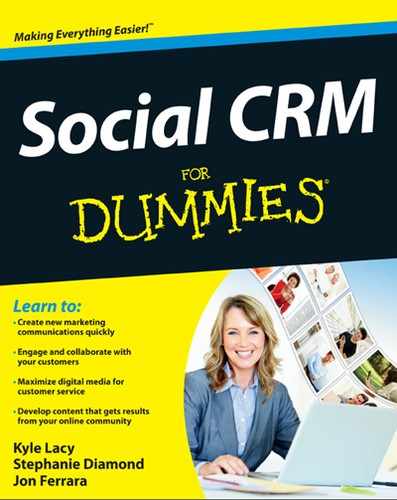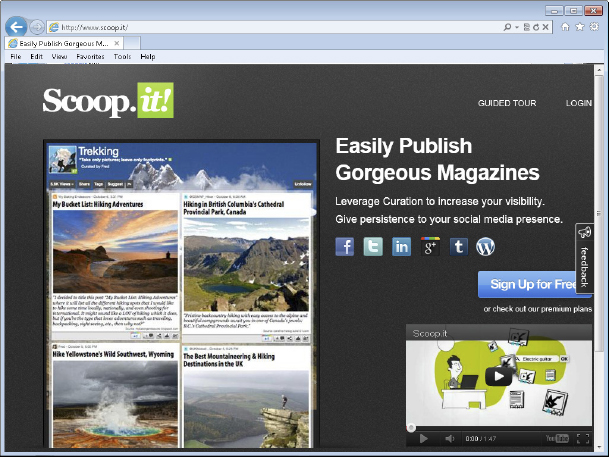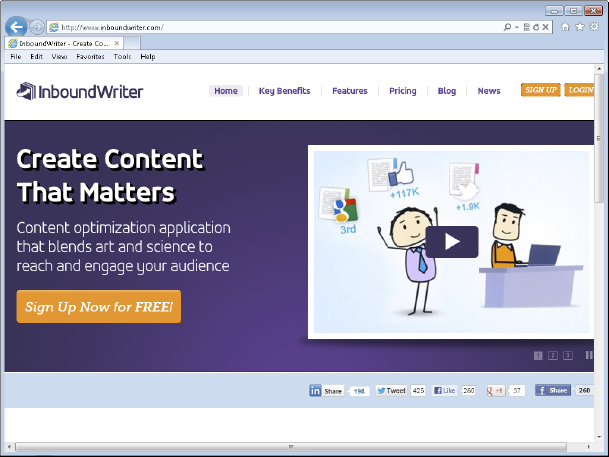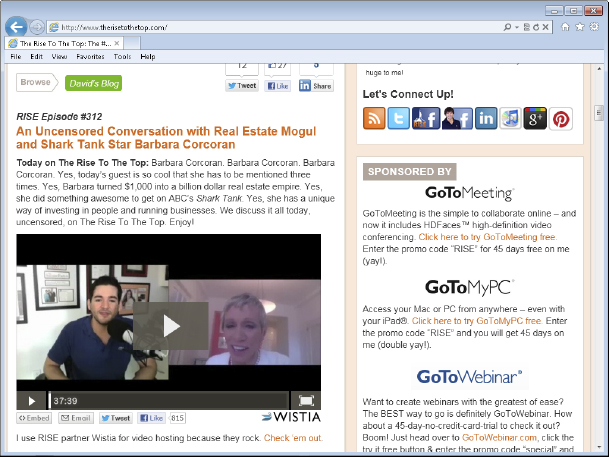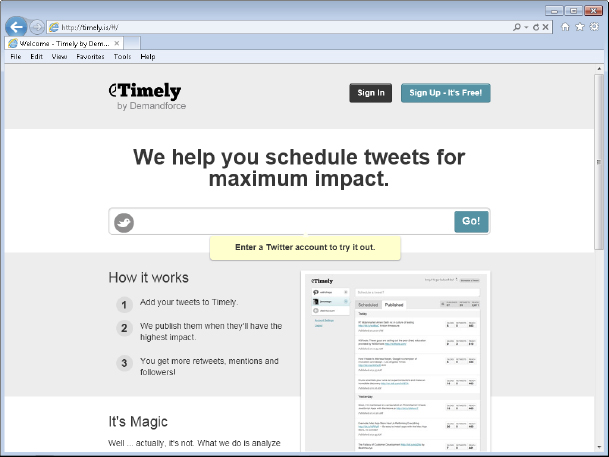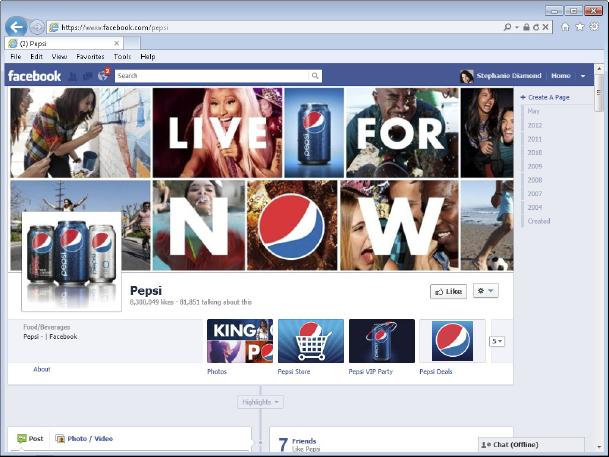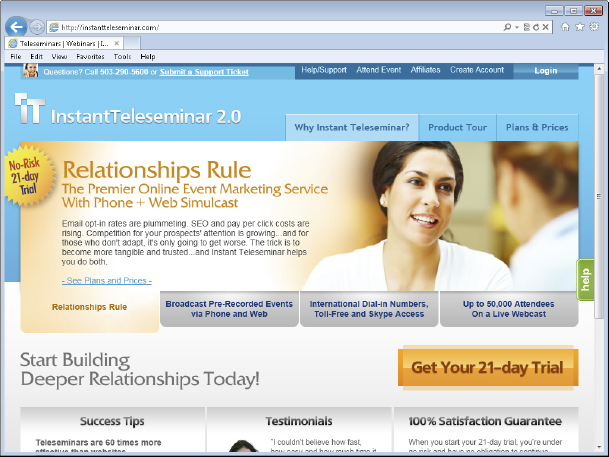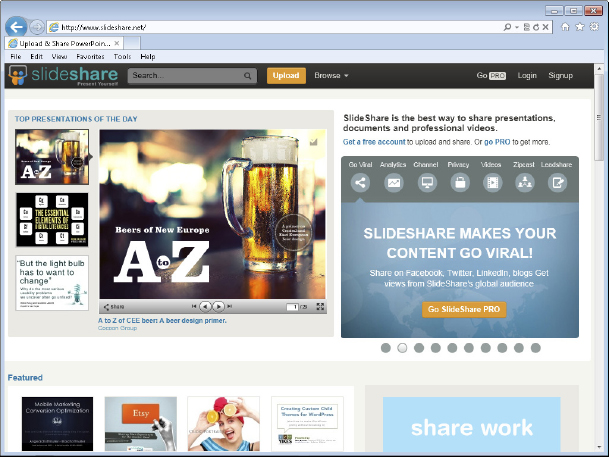Chapter 7
Using the Social Media in Social CRM
- Understanding why social media matters
- Choosing the right social media tools
- Creating a powerful blog
- Harnessing the use of content
- Attracting customers with video
- Getting traction from Twitter
- Using additional platforms for attention
- Reviewing the Facebook Timeline
- Presenting as a social media tactic
There's a conversation going on. A majority of your customers are engaged in a discussion about brands they like, the service they don't, and just about everything in between. If you're not part of it, you're missing out on an opportunity to learn what your customer really wants. The customer is ready to tell you.
But you need to listen in a way that is meaningful for your customers and your business. Auto magnate Henry Ford was quoted as saying, “If I asked my customers what they wanted, they would've said a faster horse.” Developing a relationship with your customer is a careful blend of understanding and vision. But make no mistake; social CRM is also big business. Forrester Research predicts that software to run corporate social networks will be a $6.4 billion business by 2016.
In this chapter, we show you the implications that social media have for every aspect of your business. We examine the rules for creating valuable content and the need to collect and track behavior.
Understanding the Role of Social Media
Social media has impacted many facets of our lives. When you consider that social media is a relatively recent phenomenon, you can see just how big an impact it has made. Everyone seems to be online and using social media.
According to the Nielsen Social Media Report from the third quarter of 2011, the average social media user is
- Gender: Female
- Age: 18–34
- Ethnicity: Asian or Pacific Islander
- Location: New England
- Education: Bachelor's degree or higher
- Household income: Less than $50,000 per year
That's how Nielsen describes the average user, but what about your customer? Do you know who he or she is? Your customers might not look anything like the average user. Knowing who you're speaking to is the key to a successful online business. Speaking to your audience through social media is the way to have the most impact.
Social media can be viewed as a two-sided coin used to establish relationships. It is both an experience and technique. From your customer's point of view, it's an experience. From your point of view as a businessperson, it's a technique. If you don't understand both sides, you won't develop the kind of full relationship you hope to achieve with your customers.
The following are ways to think about each side of the coin:
- An experience: Your customers interact online with their family, friends, and followers. They can exchange opinions, recommend products, or just share daily updates. They experience social media as a vehicle to interact with others around the world.
- A technique: For your business, the tools are available to develop a relationship with your customers. Not only do you interact, but you sell, provide information, and drive traffic to your channels.
If you think of managing social platforms as only a technique and not also an experience, you miss out on the richness of the relationships that can be formed. You need to see the potential of both to build your social CRM. Creating experiences for your customers and analyzing their reaction will help you get to know and understand them.
You want fudge with that?
Sometimes your relationship can be superseded by the unpredictable buying habits of your customers. In the spring 2012 issue of Marketing Matters from the University of Minnesota, Professor Joseph Redden points out a very strange buying habit. He reports that, “Branded products are not always consumed in isolation. Some products are experienced in concert with other products such as ice cream and hot fudge, televisions and surround-sound speakers, razors and shaving creams, designer shirts and slacks, shampoo and conditioner, even makeup. Consumers enjoy matching brands because they infer these items were specifically designed to go together.” So even though you may make the best-tasting hot fudge, unless you make the preferred ice cream to go with it, in some cases, you just won't make that sale. This shows that additional psychological factors may override social media influence.
Changing CRM with social media
To illustrate how social media has transformed CRM into social CRM, Get Satisfaction created an infographic called The Evolution of Social CRM. You can find the original infographic at Get Satisfaction's blog, at this address:
The analysis illustrates what makes social CRM so different from the business functions of previous years. The critical points in the Get Satisfaction infographic, in terms of how social CRM has changed, include the following:
- Instead of specific departments handling CRM, everyone in the company is involved in CRM.
- CRM processes used to be company centric, but social CRM is customer centric.
- Channels used to be defined, but now channels are dynamic, in that no one department can own a social media channel.
- CRM happens on the customers' time frame, not the set hours a company establishes.
- The purpose of CRM has transformed from transactions to interactions with customers.
- Whereas businesses used to handle CRM by sending messages from within the business to customers, messages now come from customers to the business using a social CRM model.
It's easy to see that social CRM requires a whole new paradigm. The customer is the center of all the action. Effective tools haven't completely caught up with the requirements. For this reason, social media tools are layered on top of typical CRM systems to gather all the needed data.
Dipping into real-time analytics
Understanding how customers respond to your material is key to producing more of the best content. To do this, you need to spend some time monitoring your campaigns, website, and other channels to see what works and what doesn't. For this reason, you should consider using one of the following realtime monitoring tools:
- Google Analytics: Because it's created by Google and has lots of free built-in features, including keyword suggestions, Google Analytics (at http://google.com/analytics) is the de facto standard for free web analytics. It's easy to set up and use. When you add a blog or other channel, you can hook it into your account.
- Adobe Insight: Many of the big-name brands use Adobe Insight, which has a variety of tools that help companies analyze their business. Find out more about pricing and features at www.adobe.com/products/insight.html.
- Clicky: Clicky provides real-time analytics data that most other applications do not (at http://getclicky.com). The real-time capability is helpful if you want to monitor a specific campaign as it's happening. It's available in a free version with reduced features and a fee version that's $5 per month if you pay the annual rate.
Building the Content Pillars
Without solid content, you'll have a difficult time attracting and holding an audience of any kind. There are several ways to look at what content means to your business. One way is to think of content as the foundation upon which you build a successful business. For this reason, some have used the term pillar content to refer to the content that you need to have to support your business. Pillar content includes the basic information that you believe your customers should know.
For example, if you run a gardening site, your pillar content would include everything you think hobbyists should know about planting and caring for a garden. As shown in Figure 7-1, Garden Guides (www.gardenguides.com) is a membership site, run by Demand Media, that provides extensive content on gardening. You can see what Garden Guides considers pillar content by looking at the main menu items. They include such topics as plants, gardening design, and organic gardening.
Creating and using content
The key to understanding the type of content that you'll create is knowing who your audience is. Are you speaking to a shareholder audience? Does your content need to convey a serious tone for potential investors?
One of the mistakes that content creators make is to use the same tone for all their content. Your social media channels are read by a multitude of audiences. You want to sing a coherent song, but you need to use more than one note.
You can find lots of paradigms used to present the ideal content process. We think that if you boil it all down, there are three key components to creating great content. You want to
- Write or curate content.
- Use the content.
- Share the content.
The following sections explore each of these ideas and identify tools to help manage your content.
Write or curate content
As anyone tasked with writing content knows, it can be challenging. You'll find books filled with advice about the many facets of developing good content. To start, you should think about the “why.” You need to ask yourself why you're writing it. What's the goal? Do you want to sell something, educate, or entertain? Probably a mix of all three would be ideal. As we discussed, when you know the tone of the piece and the intended audience, you're ready to write.
Before you starting writing a piece, assemble all your material: images, links, and anything else that must be included. (See the upcoming section, “Writing your brand post” for more on the process for developing content.)
Curating content means that you find great content on the web and share it with your constituency. As we know, the web has unlimited content. Much of it is good, but there's a lot of junk, too.
Curating content adds real value because a person with expertise is involved in selection instead of a search engine. You take the time to read and select what you consider to be the most informative material.
The following tools can assist you in content curation:
- Scoop.it: This tool (available at www.scoop.it) enables you to pick topics you want to curate and display those topics on a page for others to see, as shown in Figure 7-2. In turn, other people can rescoop the content you've shared. You can also find topics that other people are curating and follow them. You can scoop with both free and paid versions of the tool.
- Storify: This is a different type of curation tool (available at http://storify.com). It allows you to pull together your own social media content into a story. For example, if you were launching a product, you could pull together your content from your social platforms, Instagram, Flickr, YouTube, and other URLs to tell the product story. Storify is free.
- The Tweeted Times: This tool (at http://tweetedtimes.com) gathers all your tweets and turns them into your own newspaper. It's free to use and displays your tweets in an easy-to-read way by categorizing them and displaying them on one page rather than in a stream.
- Curation Traffic: This full-featured tool curates content and has a plugin version and a standalone version. This means you can curate directly from your WordPress blog or a new blog you create for this content. There is a fee. Curation Traffic (at http://curationtraffic.com) has lots of sharing features built in to grow your traffic.
Use content
When you're writing a specific blog post or a sales letter, you know where your content will be seen. If you're writing more general content, make sure that content is used immediately for some purpose. The reason for this is simple: The content monster must be fed. You have a hungry crowd that constantly wants to consume new material. People are attracted by what's novel to them. If you don't supply fresh content, they won't seek you out.
If you're not sure about all the ways your content can be used, you can always repurpose it (use it in different ways, such as turning a post into a video script) at a later date. You'll learn something about what your customer wants whenever you publish content, so keep working. You should consider everything you post as an experiment.
As the Greek philosopher Heraclitus is quoted to have said, “You can't step in the same river twice.” That's a great mindset to have when you're doing anything online. A river is always flowing and changing; so too is the web. You're speaking to different people all the time. Popular culture is also shifting so that what works for you today may not work tomorrow.
If you've written something that gets a great response, you'll know you need more on that topic. If no one reads it or comments, you'll know that writing more about it will be less valuable. Make the time you or your team works on content as productive as possible.
Share it
When it comes to social media, sharing is what it's all about. A customer using your content to learn about your products is valuable, and that customer becomes even more valuable when she recommends that product to her network. Then she becomes part of your sales force.
Following are some free tools that you can use to share content:
- AddThis: This tool allows you to put share buttons on all your channel content. Channels include social media platforms like Facebook and your blog. It also includes (at www.addthis.com) analytics so that you can see how your content is shared. These types of analytics include user statistics such as how many people clicked a link, shared content, and so on.
- ShareThis: This application, shown in Figure 7-3, enables your customers to share any content they like on blogs, websites, Tumblr, and other channels. ShareThis is available at http://sharethis.com.
Figure 7-3: Sharing content with ShareThis.
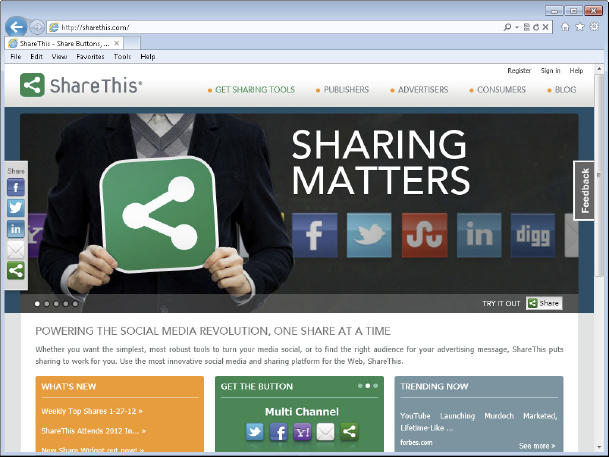
Discovering storytelling principles
Storytelling has become a hot topic for marketers and other content developers. Information overload causes customers to skip the long boring text passages that marketers carefully place on a website. From this realization, the phrase customer engagement was born. Managers began to understand that they were going to have to work a little harder to capture someone's attention. As marketing guru Seth Godin famously declared, “interruption marketing” is dead.
Customers want to consume their marketing content using games, videos, funny tweets, and so on. What they don't want is the dry, dull corporate-speak that populated the web in the early days. The competition is fierce, so all eyes turned to Hollywood. Content creators realized they had more in common with the storytelling of Walt Disney than the dull documents of Dow Jones.
I'm sure you struggle with making your content engaging. Almost everyone does. Creating interesting prose had previously been the domain of novelists and script writers. Now it's your job to tell the stories. But how? Collecting and making sense of customers' comments, data logs, and marketing campaigns was never easy. Now you're inundated with data from all sides.
 To make your content memorable, you can construct your stories in the following ways:
To make your content memorable, you can construct your stories in the following ways:
- Specific users: You can seek out stories about how customers or others are using your products or interacting with your brand in some way. (See examples later in this section.) You can then cite these customers in your stories to illustrate your point. Most big companies have gotten the hang of telling stories about their products because PR companies have been helping them do this offline for years.
- Trends: Look at your data and see what it's telling you. Then you can tell your customers about themselves based on ratings or percentages. For example, imagine you're mining your data and find that a particular industry extensively uses your products. That could be an interesting story.
- Company or product: You can tell a company or product story. In addition to stories about your customers, you'll want to tell stories about how you created your product or how the brand got started.
One way to get a handle on creating engaging content is to understand what makes a great story. Well-known screenwriter Robert McKee has said that a story “unites an idea with an emotion.”
A story isn't memorable if it doesn't evoke some emotion in the person hearing it. When you've heard about great tragedies during your lifetime, you always remember where you were when you heard the news. That's because it evoked such a strong emotion that you took note of everything happening at that moment.
The following are some ways you can approach your business content from a storytelling perspective:
- Get people's attention. To do this, screenwriters use what they call a hook, which is something that catches the audience by the coat tails and won't let them go. Think about the last PowerPoint slide show you sat through. Was there anything that grabbed your attention? Probably not. You want to open your business story with something meaningful.
- Identify the hero of the story. The hero of your business story can be the product, the storyteller, or the object of the story. For example, when you watch a commercial about a cleaning product, the product is usually the hero — the product saves the dinner party from unwanted odors. But when you talk about your company's effort to get people to volunteer, the hero is the audience. You want potential volunteers to see themselves as people who can make a difference. Be clear about the hero and make his journey an interesting one.
- Give the story some emotional content. As we say earlier, make sure that what you're presenting evokes feelings. Historically, business content was written to be as unemotional as possible. Use words that evoke emotions. If the hero is in danger of losing his business or damaging his product, make the emotion sing out.
- Be clear about the desired outcome. When you tell your business story, make it clear what needs to happen to effect a positive outcome. Spell it out. It may be crystal clear to you, but your audience may have very different ideas. Never leave it up to the audience to guess what constitutes success or failure.
- Include a call to action. If you don't make it clear to your audience what you want them to do, they won't do anything. No matter where you put the story, it should tell the reader or viewer what to do after they read it.
Look at two examples that perfectly illustrate how great stories constructed for the web make a difference. In 2011, Google started a project called Project Re: Brief. The purpose was to demonstrate that the iconic advertisements of the past could be reimagined for the web using stories. They contacted the creators of several of the iconic advertisements and asked them to update those ads for today's web audience. Here's how they recreated two of those advertisements:
- Volvo's “Drive like you hate it” commercial: The gist of the original commercial, written by Amil Gargano, was that Volvo was such a substantial and rugged car that you could drive it like you hated it. No matter how tough the driving course was, it would still perform brilliantly. Google and Gargano got together and updated the story.
They decided to tell the story of Volvo owner Irv Gordon, as shown in Figure 7-4. Gordon loved his Volvo and had driven it for many years. After hundreds of thousands of miles, he reluctantly sold it. Although it was gone, he remembered it fondly. As a present to him, his sons decided to track it down and bring it back to him. Gargano and team filmed the emotional event for the commercial. By telling a true story about how important his car was to him over a lifetime, they were able to make an emotional impact and drive home the point that Volvos survive.
Here's the link to the finished commercial www.projectrebrief.com/volvo.
- Alka-Seltzer's “I can't believe I ate the whole thing” commercial: In 1972, Alka-Seltzer, a stomach relief product, ran a commercial written by Howie Cohen and Bob Pasqualina. In it, its main character and overeater Ralph laments over and over that, “I can't believe I ate the whole thing.” This saying became iconic.
Figure 7-4: Volvo's “Drive it like you hate it” commercial reimagined.
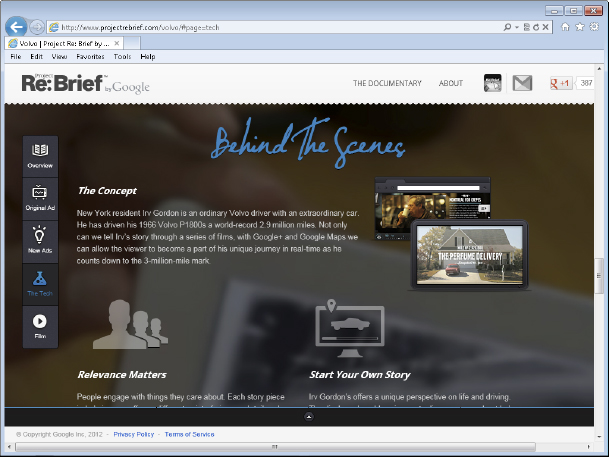
To update the story, as shown in Figure 7-5, Cohen, Pasqualina, and the Google team decided that the new version should follow Ralph throughout the fateful day when he eats “the whole thing.” In this case it's a large birthday cake. Since they were using Ralph, the same character from 1972, they designed the commercial to look like a 1970's sitcom. We watch Ralph as he tries and fails not to eat the big cake nestled in the refrigerator for the birthday party.
What makes the updated version (you can see the finished commercial at www.projectrebrief.com/alka-seltzer) unique was that it showed a complete backstory and utilizes many of the web tools Google has to offer. They provided custom coupons and links, including a link to Google+ to put Ralph in your circles.
You can see how much more appealing the information is because these old commercials are bundled as stories that take advantage of tools not available to the creators at the time like video and custom links.
 To make your social media content even more powerful, consider going back through your website and other content and reworking it to either tell a story or include stories about customers.
To make your social media content even more powerful, consider going back through your website and other content and reworking it to either tell a story or include stories about customers.
Figure 7-5: Alka-Seltzer's “I can't believe I ate the whole thing” commercial reimagined.
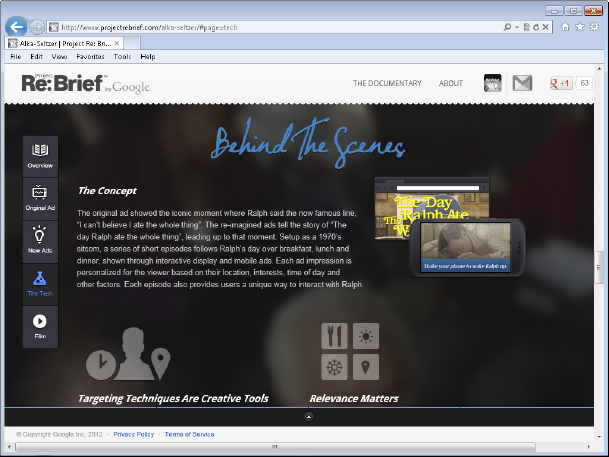
Sometimes, if you haven't thought the story through, a story strategy can backfire. Social customers can be unpredictable. They don't always do what you want them to. After a 2012 incident when a Twitter hashtag (see more about hashtags in the upcoming section on Twitter) unintentionally invited unwanted Twitter comments, Rick Wion, director of social media for McDonald's U.S.A. commented, “You don't control things. You can only hope to steer things in certain directions.”
Following is a brief description of the incident that caused McDonald's to quickly pull their social media campaign:
McDonald's wanted to showcase the farmers they work with to emphasize their interest in quality. They created a hashtag called #meetthefarmers to support the campaign. Concerned that they weren't being specific enough about what the hashtag represented, they quickly changed it to #McDStories.
But instead of getting the stories they anticipated about how fresh their ingredients are, they got a torrent of negative stories about the quality of their food. Even when they took the hashtags down, the stories continued. It was clearly a PR disaster.
This exemplifies the fact that a company vision of itself and its products may not match everyone's opinion. Whether the negative comments represented the actual customers, they were enough to stop the campaign dead in its tracks.
Should McDonald's have anticipated this response? Probably. But clearly they were thinking that they understood the social customer. They forgot that everyone with an opinion can use the hashtag, not just their loyal customers.
Did McDonald's learn a lesson? Apparently so. In May of 2012, McDonald's purchased a promoted trend with the hashtag #bluberryoatmeal to herald their new breakfast offering. This time, things went better. It seems that blueberries and oatmeal are less controversial.
Taking a trip with the customer
Sometimes the easiest way to understand your customer is to “walk a mile with his mouse.” Ok, we know that's not really how the proverb goes, but when you need to determine where your customer gets lost, can't buy, or loses interest on your website, you need to create a content trip to investigate the problem.
A content trip describes the path a customer makes to complete an action on your channel (such as a website or blog). If you take the path as though you were a customer, you can begin to understand what can be improved. If you pair that with data and feedback, you can craft a solution.
Here are some key items to consider when creating customer paths:
- Navigation: It may seem very clear when you start at the home page where you can go next, but once you get down a few layers, the organization of the content may need an overhaul.
- Shopping cart: Cart abandonment is still an issue for most online vendors. When customers get frustrated, they'll just leave their purchase sitting in the cart. That's revenue you could've had if you had taken a content trip to solve that problem.
- Returns: Don't stop at looking at the return information posted on your website. Actually order a product and attempt to return it. This can be a real eye-opener. At first, it may appear that the information you've posted is complete, but when you actually return something, you may find that the essential information is either hidden or unclear.
Keeping a content inventory
Whether you're in an enterprise or a small business, your inventory of content is likely scattered and unmanageable. Don't assume that big companies manage their content any better than small businesses. Most businesses are just too busy to organize their content.
Even if you have a web team that manages such areas as press releases or the videos collected from conference interviews, that content isn't integrated with everything else. Only companies that dedicate resources to their knowledge base will know what they really have in the way of information assets.
 You can task different groups in your company to round up content so that the job doesn't seem so massive. If one group creates most of the videos, then have that group contribute an inventory of videos. Breaking down the creation of a content inventory into small chunks is the only way you'll be able to get a handle on such a big task. Use a spreadsheet if you have to, but identify what content you have throughout your organization so that you can repurpose it.
You can task different groups in your company to round up content so that the job doesn't seem so massive. If one group creates most of the videos, then have that group contribute an inventory of videos. Breaking down the creation of a content inventory into small chunks is the only way you'll be able to get a handle on such a big task. Use a spreadsheet if you have to, but identify what content you have throughout your organization so that you can repurpose it.
Incorporating Blogging
Blogs have been around long enough that some experts have already pronounced them dead, but they are alive and well and a great source of customer traffic. They also play an important role in your social CRM. They are part of the conversation that you need to integrate into your system to ensure that you're interacting with your customers.
When blogs started in the 1990s, people used blogs like diaries or journals. They wrote mostly about their day or their interests. The blog form slowly gained favor, and businesspeople began to use blogs to talk about their brands and business. Thought leaders and others found them to be a useful way to share their expertise and build a following.
According to the Nielsen Wire blog post, “Buzz in the Blogosphere: Millions More Bloggers and Blog Readers,” more than 173 million blogs were tracked by NM Incite in 2011. Who are these bloggers? According to Technorati's report, “The State of the Blogosphere 2011” hobby blogs make up around 60 percent of the population, and business blogs make up approximately 40 percent. The Technorati report indicates the following about the business blogs:
- Corporate bloggers: 8 percent
- Entrepreneurs: 13 percent
- Professional (part-time and full-time): 18 percent
Defining a brand blog
Because of the large number of blogs, you may assume that most companies have one. Not so among the Fortune 500 companies. According to Go-Gulf.com, only 23 percent of Fortune 500 companies have public-facing corporate blogs. This indicates that many corporate managers may be reluctant to undertake an endeavor that requires a public risk.
Most successful business blogs are a fine mix of conversation, information, links, and products and/or service information. When you create a brand blog, you're usually speaking to an audience of customers, vendors, investors, and other interested parties. Because anyone could drop by, carefully consider your brand blog before taking it live.
One of the most effective ways to ensure that your company has a cohesive voice is to create a guide for your employees. (See more about employee guidelines in Chapter 13.) A guide for bloggers is akin to the type of guide you create for your brand look and feel. For example, Pepsi's ad creators (as well as ad creators for any major brand) are required to follow certain guidelines that dictate the size of the logo, the fonts, and so on. Create a guide that applies to all of your social media channels and helps everyone understand how to maintain the look and feel of the brand.
If a blog is written by the owner of a small business who has sole responsibility for everything, guest posters will be the only ones who need guidelines. If your company has financial restrictions or many bloggers, then you'll need more comprehensive guidelines. Don't regard the guidelines as restrictive. If you don't establish clear rules, you could end up in a PR mess.
Here are some questions that brand managers need to ask when creating a brand blog:
- Who will be the voice of the blog? The voice refers to the persona that the blog represents. It could be the leader of the company, an employee, a group of employees, or an outside writer. Obviously, a blog written by management will have a different style of voice than one written by a team.
Some leaders want to be visible on the web, like Scott Monty, head of social media for Ford Motors. Most avoid it. The best mix for your company depends on how you plan to leverage your blog.
- Who will have the final say before a post is published? State whether the post writer must obtain approvals before hitting the publish button. Some companies must ensure they're working within legal restrictions.
- Are you publishing copyrighted media in a post? Companies need to be careful about publishing something with a copyright held by someone else. Make sure you have the rights to publish content that's posted on your company blog.
- Can bloggers respond freely to comments or are there some restrictions? The last thing you want to do is create controversy with a reaction to a post. If comments have a negative tone, decide who must evaluate them and frame the response.
- Can bloggers recommend products (not your own) in a post? If the employee likes a product and thinks it's worth mentioning, can she do so or does she need approval? And does the blogger have to reveal whether she received a free product for review? The web is full of recommendations, opinions, and suggestions. How will your blog handle them?
 If you're looking for some ideas, you can examine the social media guidelines that IBM has created for its employees, at (www.ibm.com/blogs/zz/en/guidelines.html).
If you're looking for some ideas, you can examine the social media guidelines that IBM has created for its employees, at (www.ibm.com/blogs/zz/en/guidelines.html).
Searching the blogosphere
When you're planning your company blog, you want to make sure you get an idea of what others — especially your competitors — are doing. Make a point of looking at several blogs and taking notes about their pros and cons. Understanding how your competitors' customers respond to their content will help you craft your own. In addition, make sure to look at blogs that are popular regardless of topic. Looking at the best content will help you ensure that your blog has integrity.
The following resources can help you find your competitors and their blogs:
- Technorati: This site (at http://technorati.com)is the largest directory of blogs on the web. You can search blogs by topic and the content of posts.
- Alltop: Former Apple evangelist Guy Kawasaki created this site (at http://alltop.com). It's a curated collection of the best blogs on a variety of topics. This is a great place to start when you're unfamiliar with the blogs written on a particular topic.
- Google Blogs search: From this Google search box (at http://blogsearch.google.com), as shown in Figure 7-6, you can search all the blogs that Google has indexed, which is to say most of them.
Figure 7-6: Google Blogs search.

Planning your posts
One of the hardest parts of sustaining an active blog is to constantly feed it with new posts. To help with this process, create an editorial calendar. Most magazines and other publications maintain a calendar so that their content is created in advance. The last thing a publication needs is a big hole in its content.
A blogging schedule will help you manage blog content, whether you're working with a team or alone. If you're working with a team, you can assign posts in an orderly fashion and ensure that all your bloggers have something productive to do. If you're working alone, you need to prepare for the times when the unexpected happens and you don't have time to create a post. The key is to have something ready to go when your schedule dictates it's time to publish.
Following are some decisions you need to make to create your calendar:
- How often will you post? The best way to organize your calendar is first to decide how often you want to post. You should work at least three months in advance; some bloggers set up their schedule at the beginning of the year and try to finish the majority of their posts in the first several months.
 Don't think that just because you have all your posts planned you can't add in something timely right on the spot. The value of having posts in reserve is that you're never without a quality post to publish. You'll want to also create posts that relate to current topics and events to show your readers that you're present and interested in what's happening.
Don't think that just because you have all your posts planned you can't add in something timely right on the spot. The value of having posts in reserve is that you're never without a quality post to publish. You'll want to also create posts that relate to current topics and events to show your readers that you're present and interested in what's happening. - What themes will you select? Another facet of your editorial calendar is your themes. By establishing a theme for each month, you assure readers that you're providing ample content on all the subjects that relate to your business. You want to ensure that you have both evergreen content that you can use at any time and specific content that dives deeper into specific subjects. If you have a financial blog, for instance, one month your theme could be investing techniques, and another month it could be saving for retirement.
- What style of post will you create? A variety of well-known formats can help a blogger write more quickly and with greater variety. See the next section for a list of these format examples.
 If you want to use an editorial calendar that plugs right into your WordPress blog, try the plug-in that's available here:
If you want to use an editorial calendar that plugs right into your WordPress blog, try the plug-in that's available here:
With this tool, you can easily drag and drop posts into a calendar. This visual method is much easier than having to type in the information line by line.
Writing your brand post
Brand posts should engage the customer and make her feel like you're interested in what she has to say. Like any good social media content, you want to develop a dialogue with your readers.
It's hard to stare at a blank screen and hope inspiration will strike, especially when your job might depend on how well your blog posts are received. Management rarely buys the excuse that you just weren't inspired. If you send out posts to be written by team members or outsourced writers, give them specific instructions about the post you want. The instructions are important because you want all the posts to be consistent and use the same terms and tone. Then, when visitors read several blog posts in a row, they aren't confused by different styles.
As you write posts on your own or direct writers in the content you want, consider the following blog post formats
- Questions and answers: Your customer service department is aware of the questions, problems, and needs of the customer and can serve as a solid pipeline of content. Ask your customer service department to suggest topics for the blog. This will encourage department members to participate and take ownership of the social media discussion.
- Embedded video or podcast: Your blog should have all kinds of multimedia formats on it. If you have a podcast that was created by one of your salespeople, or a video taken at a conference, make sure you create blog posts with the content embedded right in the post.
- Several posts that constitute a series: Two of the most interesting words that any blog post can use are part one. These words indicate that more is to come. The words also set an expectation that the reader will return to learn what part two has to say. If you don't have any series posts available, try breaking a longer post into two parts.
- Product recommendations: The web thrives on recommendations. If you know of a product that you suspect your customers will like, by all means create a post about it. Also, remember to share your recommendation with the product owner. You may establish a new connection.
- Top ten lists: Everyone likes top ten lists. (Check out Chapters 16–20 of this book.) Lists are easy to understand and provide a wealth of information in a compact form.
- Tips about productivity tools: Can you advise your customers about how to do something better, faster, or cheaper? Increasing productivity is everyone's goal. These posts will be appreciated.
- Behind the scenes: People are always curious about what goes on behind the scenes. When you talk about your employees or describe an event you put on, you help to draw the audience in. Customers see that your company is populated with real people. When your customers feel a connection with the people who make up your business, this connection goes a long way toward developing customer relationships.
Fitting SEO into blog content
Search engine optimization (SEO) is a topic that many businesses would like to ignore. SEO is frustrating because it's a moving target, and there's no one right way to do everything. But you can't ignore SEO because search-engine friendly content enables people to find your blog content when they need it. As we explain in earlier chapters, showing up on social media channels when and where customers have a need is critical to a social CRM strategy.
In SEO, the greatest concern is the keywords you place in each post. For example, Google will help users find your posts if the keywords correspond to searches that your potential customers run. Google will also penalize you if you try to stuff your posts with keywords; repeating the same keywords over and over beyond their usefulness is just as bad as not using them at all. The key is to find the correct balance between including the keywords that are needed for SEO versus making the post seem overstuffed with the same words.
Your company probably has a defined list of major keywords that everyone uses. However, when you're writing a blog post, you will also want to add keywords that are specific to that post to encourage traffic. For example, if your post mentions specific industry leaders or company products, include them as keywords for that particular post. That way, people who search for those specific names will find you through that post.
Following are some tools to help you find the right keywords while you're writing your content:
- Scribe: This tool (at http://scribeseo.com) is for writers of content of any kind. For a fee, it evaluates keywords, analyzes your titles and text, and helps you build backlinks, which are links that others place on their blogs that link back to your post.
- InboundWriter: This tool, shown in Figure 7-7, uses web research to help post creators write their content. It's available at www.inboundwriter.com, in both a free and fee-based version. Among the great InboundWriter features is a tool that grades your content as you write it. You can see if you have the right balance of keywords and a title that will work for SEO.
 One keyword trick that some bloggers use to attract readers is to tie a post to a celebrity's name or major event. It's come to be known as newsjacking. For example, if Lady Gaga is in the news, a blogger might create a post entitled, “What you can learn about marketing from Lady Gaga” and include her name as one of the keywords. When someone searches for her name, that post may come up. The problem with this trick is that you will also be seen by lots of people who have no interest in your post, but it's a way to get immediate traffic.
One keyword trick that some bloggers use to attract readers is to tie a post to a celebrity's name or major event. It's come to be known as newsjacking. For example, if Lady Gaga is in the news, a blogger might create a post entitled, “What you can learn about marketing from Lady Gaga” and include her name as one of the keywords. When someone searches for her name, that post may come up. The problem with this trick is that you will also be seen by lots of people who have no interest in your post, but it's a way to get immediate traffic.
Encouraging readers to leave comments
On your blog, comments on each post help create community and build relationships. However, the value of the comments section is often overlooked. One reason may be that comments aren't easy to come by. Some blogs have a wealth of comments, but most have just a few. Social customers are more likely to comment within a social media platform like Facebook than on a specific blog.
The kinds of comments you want on your blog are the ones that invite discussion by a larger group. To encourage readers to leave comments, especially comments that generate discussion, help your readers frame their responses. For example, in a blog post, ask readers specific questions that they can reply to. Replying to a question is an easy way for your readers to interact with you. You could also describe an experience that happened to you and ask readers to share a similar experience. Broad questions aren't as likely to generate comments. When you ask readers to simply “Let me know how you feel,” you're inviting a blank comment box.
Looking at the available blogging tools
Blogging tools are relatively easy to use. They're structured so that you use a template to fill in all the required information that helps search engines find you. This information includes the title, text, keywords, images, and links.
The following two tools are especially popular among business bloggers:
- WordPress.org: This tool — shown in Figure 7-8 and available at http://wordpress.org — is the most widely used platform to create websites and blogs. To create a relatively inexpensive yet professional-looking site, purchase predesigned themes. A host of plug-ins extend WordPress.org functionality. To avoid confusion, be aware of the tool called WordPress.com that hosts WordPress sites. Wordpress.org sites are hosted on your own site.
- Typepad: With Typepad (at http://typepad.com), you create and host a blog on the Typepad site. You can customize your design, and the fee you pay includes technical support.
Figure 7-8: WordPress.org download.
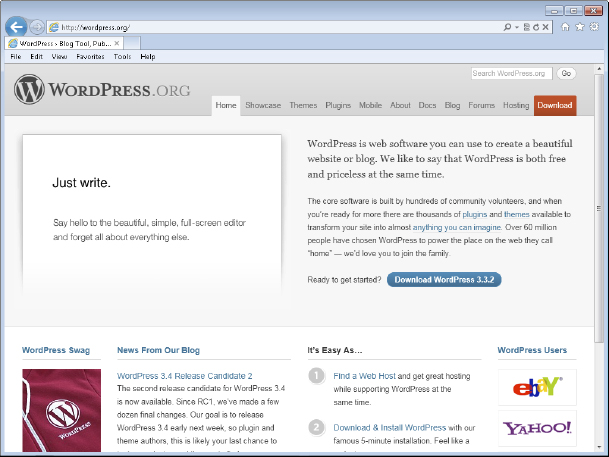
Discovering the Podcast
No company using social media should overlook podcasts. A podcast is an audio file that listeners can either directly download to their computer (or mobile device) or stream (play) online. It's most likely formatted as an MP3 file. (In this definition and the research that follows, songs are excluded.) Podcasts allow companies to vary the content format.
When podcasts were first introduced early in the 21st century, the technology wasn't perfect, and downloading was difficult. As the technology improved (including the introduction of the iPod), podcasts became more popular.
Now, most companies understand that podcasts have value, but they don't always use them to the extent that they could. The problem isn't hard-to-use technology, but finding people who are willing to speak at length in a nonrehearsed way. Just like any public speaking, discussing a topic in a podcast requires the willingness to try.
Defining the value of podcasting
To understand who podcast listeners are and what social media they consume, a survey, The Current State of Podcasting 2010, by Edison Research, found that the average podcast listener is
- Male: Fifty-three percent are men.
- Neither young nor old: Twenty-two percent fall into the 35–44 age range.
The percentages of people on social networks who listen to podcasts are as follows:
- 66 percent of Facebook users
- 19 percent of LinkedIn users
- 15 percent of Twitter users
Apply the preceding statistics to your company's podcasting strategy. For example, because a high percentage of Facebook users listen to podcasts, if your audience is on Facebook, consider linking to a podcast via your company's Facebook page. Is your audience in the 35–44 age range? Then podcasts could be your medium.
As you develop your podcasting strategy, don't go by these statistics alone. Do testing on your own by tracking them in Google analytics or other analytics package. This way, you will know if your assumptions about your audience are borne out by real-world tests.
Benefitting from podcasts
Are podcasts of interest to you? Here are some ways that creating podcasts could benefit your company:
- Listeners can hear a podcast anytime. No one has to listen to a podcast as it's being recorded. They can listen at a time that's most convenient for them. This makes it more likely that your podcast will be heard.
- Listeners can multitask. With a mobile device, customers can use your podcast to entertain or educate themselves while they're out and about, running errands or commuting. In this way, you remind customers about your business even when they aren't at their desk.
- Podcasts are easy to forward. Podcasts are digital, and fans can easily forward links to them on blogs, social media sites, or through e-mail.
- Your customers can easily subscribe to a podcast series. Several tools, such as iTunes, make subscriptions easy. If you have an ongoing series, make sure your customer doesn't have to search for it. Post all podcasts in a series in one place and clearly label them.
- Your company can create its own talk show with very little effort. Talk shows used to be the domain of major radio stations. Now you can hear talk shows about almost any topic.
- You can create products that include podcasts and generate revenue. Podcasts are perceived as more valuable than text. If you're creating an information product, for example, consider bundling several podcasts in it.
- You can record meetings with customers and send the recording as a follow-up. If you're consulting or providing custom training, a recording of the conversation would be appreciated. It could be viewed as a premium service.
- Professionals who hear your podcast may call you for speaking engagements or other deals with your company. You never know who might take an interest in your podcast. Journalists, conference organizers, and business owners are all listening.
- When your company launches a new product or service, you could interview the product manager to explain its value to consumers. You can use your podcast as a marketing vehicle to get your message out to potential customers.
 Look over your inventory of content and see if something your company has already created would make a good podcast. Put a catchy title on it to help capture attention.
Look over your inventory of content and see if something your company has already created would make a good podcast. Put a catchy title on it to help capture attention.
Planning your podcast
Recording a great podcast can be challenging if you don't plan what you're going to do ahead of time. The first step in planning is to gather inspiration by listening to popular podcasts. The following podcasts were among the nominees for the Podcast Connection's 7th Annual Podcast Awards:
- Planet Money from NPR: Check out the contest winner at www.npr.org/templates/archives/archive.php?thingId=127413729, as shown in Figure 7-9.
- Market Foolery by Motley Fool: At http://wiki.fool.com/MarketFoolery, you can listen to brothers Tom and David Gardner discuss the latest business and investment topics with a fresh approach.
Because these podcasts represent one of the final nominees and the winner, the standards are high. Don't be intimidated by the quality and content. Just try to see what makes them so interesting.

When you're gathering your team or planning a podcast on your own, consider these tips:
- Make sure you're comfortable with the technology. If you find it difficult to run the equipment and host the podcast at the same time, get someone to help with the technical duties — not the least of which is to hit the record button. Having someone to turn to can be a real lifesaver when something goes technically wrong in the middle of a great interview.
- If you're interviewing, speak to the guests ahead of time. Ensure that they know what the show is about and what's expected of them. Even though this sounds like common sense, we've all heard podcasts that include confused guests.
- Clarify your call to action. You want to let your audience know where they can go for further information. If you're pointing listeners to a website, check the URL ahead of time to ensure it's correct, and write down the link so you're sure to repeat it accurately during your podcast. You don't want to issue corrections along with the podcast. During your podcast, repeat the web address frequently. If your call to action is a limited-time offer, note the date it expires. You don't want to disappoint potential customers.
Choosing podcasting tools
To create podcasts, you can choose from several types of tools. Your choice will depend on such things as the following:
- Where do you want to store and retrieve files?
- How many files do you want to create?
- What will your file size be?
- Are you working alone or with a team?
The different types of tools are as follows:
- Record and store in the cloud. You could use a service that stores your files in the cloud (on someone else's computers).
- Record and store on your company's computers. If you have an IT team to manage files, you may want to store your files on your company's equipment.
- Broadcast over the Internet and store in the cloud. Tools like these enable you to create your own talk show. Blog Talk Radio, an example of this type of tool, is shown in Figure 7-10.
In Table 7-1, you find an example of each type of podcasting tool.
Table 7-1 Examples of Podcasting Tools
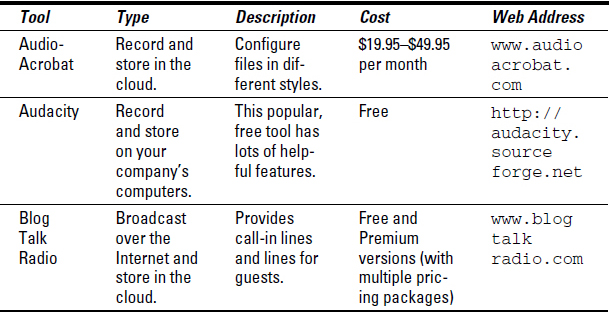
 If you have a WordPress blog, you can use a free tool called Audio Player to create your MP3 podcasting files. The colors of your player are configurable so that you can match your site. You can find Audio Player at this address:
If you have a WordPress blog, you can use a free tool called Audio Player to create your MP3 podcasting files. The colors of your player are configurable so that you can match your site. You can find Audio Player at this address:
Getting your podcast heard
After you've created a podcast, the next step is to spread the word to potential listeners. If you're creating podcasts for an internal audience, your distribution is clear. If you want to attract traffic to your website, attention to your product, or credibility as a thought leader, you'll need to find wider distribution.
One good way to figure out where to distribute your podcast is to look at how people find podcasts. The Edison Research's 2010 report on the state of podcasting (mentioned earlier in this chapter) asked its respondents the following question: “How do you typically find out about the podcasts you listen to?” Their responses were as follows:
- 32 percent said iTunes
- 20 percent said recommendations on social networks
- 13 percent said search engines
- 7 percent said recommendations on blogs
- 29 percent said other (these could include newsletters, e-mails, and so on)
We recommend using all these channels and any others that relate specifically to your audience.
Including Video in Your Mix
Video has become a very important content format for social media users in the last few years. Its impact on the web is enormous. In February 2011, com-Score Video Metrix released the following data about online video viewing:
- 82.5 percent of the U.S. Internet audience viewed a video online.
- U.S. viewers watched online video for an average of 13.6 hours per viewer in February 2011.
- The average video was 5.1 minutes.
Most people like the idea of using videos. The problem arises when you have to shoot videos. You have to figure out answers to all sorts of questions. What should I shoot? How should I do it? Unless you outsource videos or work in a company with a video studio, you're going to learn more about taking video than you ever expected. The following sections help you create a plan for your online video.
Knowing how to use videos
Before the bandwidth and technology for online video became available, businesspeople and users alike eagerly anticipated online video. Now that it's here, everyone is hoping to launch the next viral video (as long as it goes viral for a good reason, not because it's a PR disaster).
Your customers can view your videos in two main ways:
- From a link: If you want to link to a video, you must first upload the video file to a hosting site or your own site. Then, you can link to a video in almost any e-mail, blog post, tweet, or other social media message box. The link points to the video's Internet address. When the viewer clicks the link, he watches the video on the site to which you uploaded the video file.
- Embedded: The other way your fans can view your video is directly from your website, as David Siteman Garland does in his blog The Rise to the Top (www.therisetothetop.com), shown in Figure 7-11.
You can also embed the link from YouTube and send it via e-mail or other source to be viewed. You still need to upload your video file to a hosting site or your own site before you can embed the video. But instead of clicking a link, your viewer clicks a Play button to see the video, or the video can play automatically as soon as a visitor lands on the web page that contains the video.
You can create videos to serve a variety of business purposes. Consider the following:
- Marketing current products
- New product announcements
- Advertising
- Interviews
- Customer service
- Training
- Conference activity
Figure 7-11: Embedded video on The Rise to the Top.
After you decide what to create, you need to figure out how to proceed. Depending on what you're shooting, you can use a relatively inexpensive video recorder or even a smartphone. When you want to grab an interview with someone on the fly, these devices will suffice. Obviously, if you're recording a more formal event such as a speaker at a conference, you'll need a more professional rig that includes a good microphone.
Understanding video-hosting requirements
Video hosting is an important consideration. If you don't want to host videos on your site, you need to pick a host that will serve your needs. When you're reviewing sites, consider the following:
- How well can you customize the player? You want to make sure that if you're paying for site hosting, you can create a professional-looking player.
- What kind of limits can you put on privacy? You want the ability to control who can see your videos and under what circumstances. Check whether you can you can password-protect the video or prevent others from e-mailing the link. Privacy is a consideration if you want to limit viewing to a select audience, such as a training class.
- What kind of analytics does the host provide? Reviewing your analytics will help you make better videos. You want to see data such as how many times a video was viewed and for how long.
Following are some possible video-hosting sites (see the upcoming section on YouTube) to consider for your business:
- Vimeo: Shown in Figure 7-12, this popular site has both a free and fee-based option. Vimeo (at http://vimeo.com) does a good job of helping you share your video on social networks.
- Screencast: This service (at www.screencast.com) is inexpensive or free. The same company that provides this service, TechSmith, also makes Camtasia, the video-recording software.
- Wistia: When you pay for video hosting at Wistia (http://wistia.com), you also get helpful analytics and built-in way to create a call to action within your video.
- Viddler: This option (available at http://viddler.com) is designed specifically for business videos and can handle most video file formats.
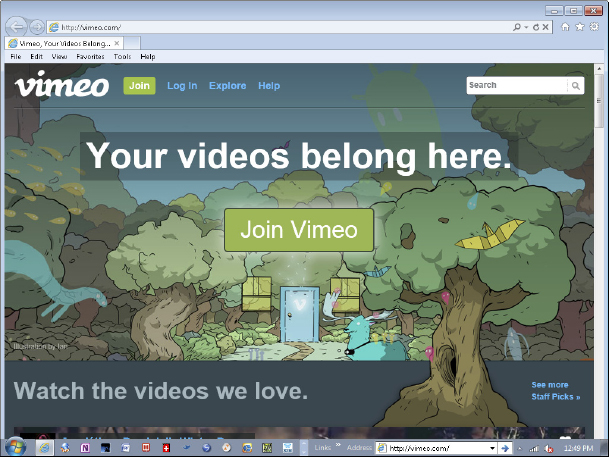
Considering YouTube for video hosting and distribution
When you are evaluating how to distribute and host your videos, you may want to consider YouTube where you can do both at the same time. Its built-in features make it worth considering. You can host a video in a variety of places that don't have distribution. What makes YouTube valuable is that they have a huge waiting audience to which you can distribute videos.
The benefits of using YouTube for video distribution include the following:
- There aren't many restrictions on topic. After you register for a subscription, the site accepts videos on almost any subject. That's great news for businesses whose videos may not be about exciting topics.
- Signing up is free. You don't pay a fee, but your videos are public.
- You can create your own channel. You can brand your own channel with your colors and logos. Check out what Orabrush has done in Figure 7-13.
Figure 7-13: Orabrush on YouTube.
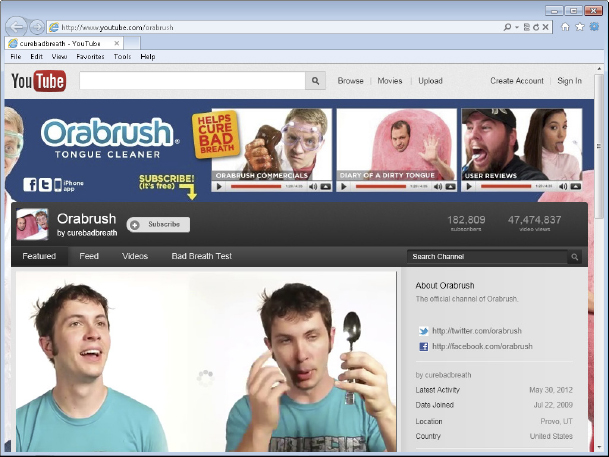
- You save storage costs. You can send customers to view your videos on YouTube instead of incurring the cost of storing videos on your own site.
- Your customers can subscribe to all your videos or select one and add it to their Favorites list. Your customers can sign up to receive notices about new videos so that you can keep them updated.
- Built-in analytics are available. If you post a product video or a video on another topic that you want to track, you can see how many people watched and accessed other measures of your video's success by using YouTube's built-in tools.
- The site offers a huge audience. You may find new customers when people search the site for your topic; YouTube is one of the top websites.
 Of course, using a no-fee public service like YouTube to host your videos has downsides. For example, if you assign an employee to manage the YouTube site, you need to make sure you have the password as well, or that you can get in if the employee is unavailable.
Of course, using a no-fee public service like YouTube to host your videos has downsides. For example, if you assign an employee to manage the YouTube site, you need to make sure you have the password as well, or that you can get in if the employee is unavailable.
Tweeting with the Microblog Twitter
People either love or hate Twitter. The ones who hate it say they just can't pack enough meaning into 140 characters. The ones who love it say that they can establish relationships with people they could never reach any other way. Twitter lovers have an important case to make for anyone involved in social CRM. Because Twitter is such a powerful tool for reaching out to people, you can't ignore it. According to statistics compiled by Cara Pring at The Social Skinny,
- There are over 465 million Twitter accounts.
- Twitter is growing at a rate of 11 accounts per second.
- 30 percent of Twitter users have an income over $100,000.
Twitter creates the opportunity for the pint-sized post that packs a wallop. In this section, we look at the true value of making Twitter part of your social CRM ecosystem.
 When you create a Twitter account, you're required to pick a name for your profile. Think about the name carefully before you choose it. If it's a company name, consider whether you intend to use the account for a specific department or purpose, such as customer service, and choose a name that reflects that purpose. You can always add another account, but you risk diluting the main one if you do. Start by concentrating your efforts.
When you create a Twitter account, you're required to pick a name for your profile. Think about the name carefully before you choose it. If it's a company name, consider whether you intend to use the account for a specific department or purpose, such as customer service, and choose a name that reflects that purpose. You can always add another account, but you risk diluting the main one if you do. Start by concentrating your efforts.
 If you're just getting started on Twitter, you may want to follow an account like TweetSmarter (https://twitter.com/#!/tweetsmarter). What makes this account unique is that it's run by two people (Dave and Sarah Larson) who directly answer your questions and try to help you better understand Twitter.
If you're just getting started on Twitter, you may want to follow an account like TweetSmarter (https://twitter.com/#!/tweetsmarter). What makes this account unique is that it's run by two people (Dave and Sarah Larson) who directly answer your questions and try to help you better understand Twitter.
Understanding the microblog (Twitter)
Just like the hours in the day, you get the same amount of Twitter characters as everyone else: 140 characters, including spaces. If you use them wisely, you can reach a large audience. Twitter allows you to easily connect with your niche. No matter what your interest or business specialty, you can find like-minded followers on Twitter.
 However, you need to be aware that when you create a Twitter account for your business, you're committing to actively responding to customer thoughts and opinions. By having the account, you raise customer expectations that you're listening.
However, you need to be aware that when you create a Twitter account for your business, you're committing to actively responding to customer thoughts and opinions. By having the account, you raise customer expectations that you're listening.
But are you? According to a 2011 study by Maritz Research, only 30 percent of the people surveyed received a company response to their tweet. This unresponsiveness defeats the purpose of having a Twitter account as part of your social CRM. Not only do you want to show customers that you care about what they have to say, you also want to capture data about your loyal followers. You won't be encouraging them if you don't engage.
From a big-picture perspective, tweets serve two basic functions:
- Tweets send out content within the tweet itself. Within 140 characters, you are free to say pretty much anything. Comments can include quotes, opinions, and responses to others, and you can attempt to reach out to someone new.
- Tweets provide links to other content. You can include in your tweet a URL that takes your audience to another place on the web. These tweets have additional value because they can drive traffic to your channels, promote a product for sale, or alert followers to additional information you want to share.
Tweets allow you to communicate with others in real time. If you monitor your Twitter stream throughout the day, you'll see brand mentions and developing news right in your stream and in trending topics.
Reviewing Twitter basics
To participate in the tweet stream, it's useful to know something about the elements that make up Twitter. Following are some of the key parts:
- Tweet: This is the basic unit. When you create a Twitter account, you start by typing in the box that says Compose New Tweet. The tweet is then posted in the stream and people who follow you can see it.
- Direct Message (DM): A direct message is one that is sent directly to a Twitter address and doesn't go into the stream. It's a private communication between you and another user.
- Followers: This is what Twitter calls the people who choose to read your tweets.
- Retweet: When you like what someone has tweeted, you can click the Retweet button to send it back out into your stream. You can type RT and the person's handle, to identify who wrote the original. It looks like this: RT @person.
- Hashtag: This is a search tool that people create by placing a hashtag symbol (#) in front of a keyword so that people can follow a specific topic. For example, if you're holding a conference, you might want to create a hashtag for that event so that people can see all the tweets related to it.
- Promoted tweets and trends: Twitter sells advertisers the ability to tie a tweet to a particular search term. If the search term is used, the tweet shows up at the top of the results list. Advertisers can also select a mobile platform (such as Android, Blackberry, iOS, and so on) where the tweet will show up.
A promoted tweet lets advertisers pay for a tweet to show up at the top of the trend list. The promoted tweet is tied to a keyword related to upcoming events or holidays. For example, if an advertiser's product is related to Thanksgiving, the advertiser should tie the tweet to that search term.
 Twitter allows you to create a custom background for your profile. If you create one, make sure it matches your company branding. You don't want to confuse your followers.
Twitter allows you to create a custom background for your profile. If you create one, make sure it matches your company branding. You don't want to confuse your followers.
Looking at some specialized Twitter tools
A whole industry of tools has grown up around Twitter. People have figured out ways to make it easier to follow and use. For example, here's a quick introduction to tools that can help you with the following tasks:
- Grade your account. You may want to analyze how well your Twitter account performs compared to others in the Twitterverse. If your manager wants to know where your company stands, use these tools.
Twitalyzer is shown in Figure 7-14. The free account (you can sign up at http://twitalyzer.com) shows you analytics, including what percentile you rank among all Twitter users and the average age and gender of your followers. For example, if you have a rank of 80percent, that means that 80 percent of Twitter users rank lower than you do on a scale of 1–100 percent.
Tweet Grader (http://tweet.grader.com) is also a free tool. You are assigned a grade based on such things as number of followers and length of time you've been on Twitter.
- Find the best time to tweet. You want to tweet when the most eyeballs are available. These tools help you figure out when you'll get the largest audience viewing your tweets. Whether your followers want to retweet your content is still based on the value of the tweet itself.
TweetStats is a free service (at http://tweetstats.com) that analyzes the best time for you to tweet and shows it to you in a graph.
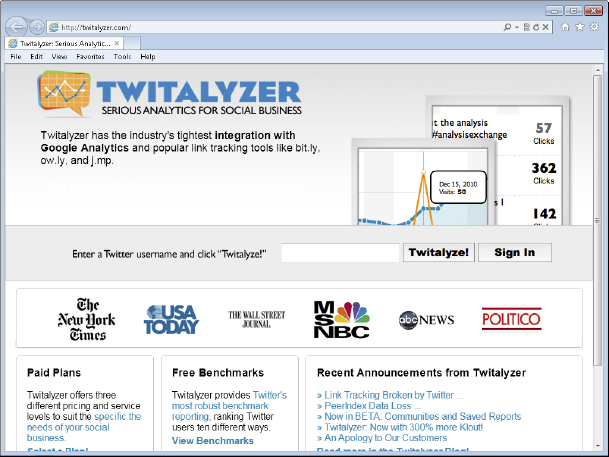
Tweriod, shown in Figure 7-15, is also free (go to http://tweriod.com). Tweriod sends the analysis to your e-mail or DM on Twitter.
- Find tweets on a particular topic and display them on their own page. If your followers are interested in a particular topic, you can create a page that displays tweets on only that subject.
Tweetwally enables you to do just that (at http://tweetwally.com). You can provide a link to your Tweetwally topic from your blog or other channel. For example, author Stephanie created a Tweetwally on visual thinking, as shown in Figure 7-16.
- Provide analytics for your Twitter account. You want to know more about your Twitter account than just number of subscribers. You want to know about their demographics.
SocialBro (www.socialbro.com) provides statistics through Google's Chrome browser, or you can download the SocialBro app to run from your desktop. This service provides an interesting mix of analytics and management. You can see your community mapped out via location or find out who your newbie followers are.
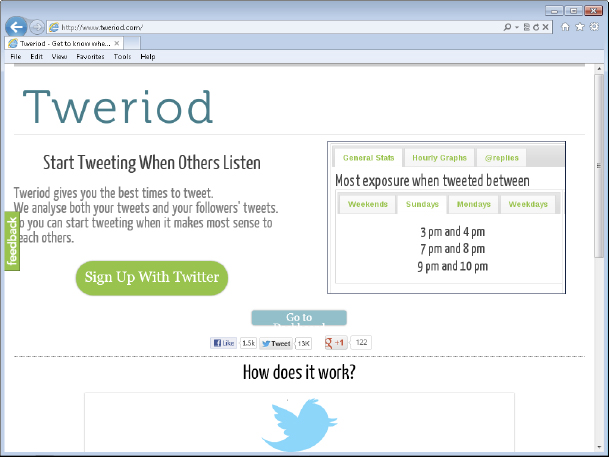
- Schedule your tweets to be sent out over a period of time. These tools are handy for timing your tweets based on feedback you get from tools like Tweetstats or Tweriod, mentioned earlier in this list. Scheduling tweets is also useful when you need to disconnect from the Internet but still provide content via Twitter. (Still, make sure someone is minding your company's Twitter account for feedback from your customers, even when the main person needs to step away.)
Buffer provides free and fee-based services (at http://bufferapp.com). The application stores your tweets and sends them out on a schedule of your choosing. It also has built-in analytics.
Timely (http://timely.is) is another free and fee-based tool that allows you to time your tweets, as shown in Figure 7-17. Timely is easy to use: You type your tweets into the application and choose how often you want them to be sent to Twitter. You can also see the performance of the tweets and learn which tweets get the most attention.
 Even though social media is gaining a huge foothold, most businesses still use e-mail as their main way to communicate. Don't forget to consider e-mail when you're developing your campaigns. According to a 2011 presentation by Jeff Hardy at SmarterTools, Facebook hosts 60 million updates per day and Twitter hosts about 140 million tweets per day, but people send a billion e-mail messages per day.
Even though social media is gaining a huge foothold, most businesses still use e-mail as their main way to communicate. Don't forget to consider e-mail when you're developing your campaigns. According to a 2011 presentation by Jeff Hardy at SmarterTools, Facebook hosts 60 million updates per day and Twitter hosts about 140 million tweets per day, but people send a billion e-mail messages per day.
Facing the Valuable Facebook
Facebook is the 800-pound gorilla. In March 2012, it had over 900 million monthly active users. If you know anything about social media, you know that Facebook is considered the platform to be on. Its sheer size makes everyone pay attention. But just like any site or tool, you have to make Facebook work for your specific business.
Understanding the importance of Facebook
In 2012, Facebook is facing some challenges. Its IPO was investigated by the Securities and Exchange Commission, and General Motors pulled all its advertising. Like any other publicly traded company, Facebook is open to a higher level of scrutiny, but no one expects a mass exodus of users in the near future. According to comScore, one out of every seven minutes spent online is spent on Facebook. That's a hard habit to break.
Discovering Facebook features
A study by CMB Consumer Pulse and iModerate Research Technologies reports that of those who click a brand's Like button on Facebook, 60 percent of them are more likely to recommend that brand. That gives most brands a reason to be on Facebook.
To maximize your use of Facebook for your brand, following are some of the most popular features for you to consider:
- Timeline: At the end of 2011, Facebook released a new feature called Timeline. In his introduction of Timeline, Mark Zuckerberg said that its purpose is to keep a visual record of your life. As you look back through the months and years, the Timeline shows your posts, activity log, photos, and so on. This sounded like a great concept to many.
When the Timeline feature was rolled out, users realized that there were some things they didn't want prominently displayed there. Perhaps some photos, events, comments were best left hidden. For this reason, Facebook allowed users a good deal of time to remove any items they didn't want displayed. For businesses, Timeline helps them keep their content visible and circulating.
- Cover photo: One of Timeline's features is a large photo at the top of the page. This photo, Facebook says, should demonstrate your individuality. Brands like Pepsi have made good use of this feature, as shown in Figure 7-18.
- Followers: This is Facebook's term for people who choose to follow your brand's News Feed. When visitors are on Facebook, brands believe there is prestige in having a high number of followers because it shows that many people are engaged and interested.
- The What's on Your Mind box: This is where you post your content, including links to your other channels, thus driving traffic.
- The Like button: When you click the Like button, you're signifying that you like or appreciate the content or the brand. This allows Facebook to include the brand's content in your News Feed. There is some debate about whether likes translate to revenue, but no brand wants to turn away likes.
- Facebook advertising: Facebook has an audience who is massively engaged with its content. The reason for this is that the content they see is from friends, colleagues, and family. In this age of information overload, recommendations by people you know are highly valued. It may be for this reason that the value of advertising on Facebook is hotly debated.
Figure 7-18: Pepsi's cover photo.
As mentioned earlier, General Motors pulled its $10 million ad campaign from Facebook. Contrast this with Ford, who said its ad buys are doing just fine. Every advertiser has to be able to convince themselves that their investment is providing a real return. A May 2012 poll by the Associated Press (AP) and CNBC found that in the U.S., 83 percent of Facebook users said they “hardly ever or never” clicked online ads or sponsored content. This is a developing story.
Adding Specialized Social Platforms
In most of this chapter, we discuss the major platforms that most companies who use social media choose first, but other specialized sites might be just right for your business. If you have a niche that's clearly defined, you might find another network that's perfect for your business.
Considering social network alternatives
If you think that being on the major sites assures that your customer will find you, think again. Is there something unique about your product or service that lends itself to one of the less traveled social networks? They include the following:
- Google+: As this book goes to press, the success of Google+ (at https://plus.google.com) is still an open question. Because of its late entry into the social network scene, users have been reluctant to add yet another social network to their to-do list. At the end of 2011, Google+ was reported to have 62 million users, whereas Facebook, as of April 2012, had a reported 900 million active users. When you compare the two, the number of people on Google+ makes it seem like a start-up.
But don't ignore Google+ as a potential social network for your business. One of the important things to remember about Google+ is that it's tied to the Google ecosystem. As we all know, it takes effort to get on another social network, so Google+ users are there because they want to be. It's not a me-too proposition.
Social media thought leader Chris Brogan, President of Human Business Works, abandoned Facebook at one time to operate from Google+. He also wrote a book called Google+ for Business: How Google+ Changes Everything, so clearly he's a fan.
 What does Brogan say about Google+? He's quoted in a 2012 article at online news source InTheCapital saying, “Go on Google+ looking to establish a place where you can share information that might help with customer acquisition and community nurturing.” He recognizes the value.
What does Brogan say about Google+? He's quoted in a 2012 article at online news source InTheCapital saying, “Go on Google+ looking to establish a place where you can share information that might help with customer acquisition and community nurturing.” He recognizes the value.One of the unique features on Google+ is that you can segment followers into circles, as shown in Figure 7-19. After you've established a circle on a specific topic, you can read and post to that circle directly. The circles feature gives you the opportunity to send the right message to the right group.
- LinkedIn: If you work for a B2B company, you may want to consider using LinkedIn (www.linkedin.com) as one of your social platforms. (See Chapter 8 for more on this.) In March 2012, a HubSpot survey called the State of Inbound Marketing found that 62 percent of the respondents said they acquired a customer from LinkedIn.
LinkedIn has over 100 million users who have uploaded all sorts of business information about themselves. In addition, LinkedIn has all sorts of special-interest groups that you can join to meet like-minded people. Everyone on LinkedIn is interested in networking with other business people, so LinkedIn is fertile ground for prospecting and developing customer relationships.
Using visual platforms
Some popular social networking sites that emphasize visuals have been cropping up of late. The following two make sharing graphics and photos very easy:
- Pinterest: Launched in 2009, in its short life, Pinterest (https://pinterest.com) has become the darling of social media. According to comScore, Pinterest hit 10 million users faster than any other site. It has also been demonstrated that Pinterest's referral rate is higher than that of Facebook. Referral rate refers to the rate at which Pinterest users refer their pins to others.
Pinterest is a visual site. The majority of users are female. When someone pins (shares) a photo of interest to their board, another interested pinner can pin it on their board. In this way, the photos can create traffic to the pin's original site.
Pinterest allows you to add prices to your pins and places them in the upper-left corner. (See the Gifts navigational tool at the top of the Pinterest home page for pins with pricing info.) If you have great-looking graphics or photos of your products or services and your demographic skews female, you may want to consider Pinterest.
- Tumblr: Some consider the microblog Tumblr (www.tumblr.com), shown in Figure 7-20, to be a more visual version of Twitter. Tumblr is very customizable and allows almost any content format: photos, quotes, links, music, and videos. According to Tumblr's own site, as of February 2012, Tumblr has over 46.2 million blogs. Tumblr's growth has been very rapid. Between 2010 and 2011, it increased 218 percent. This made the social media community take notice.
On average, Tumblr users are young. comScore reports that half of the users are under age 25. If this is your demographic, consider creating a Tumblr blog.
Presenting as a Social Campaign Tool
When considering content creation, some companies don't realize that presenting is a powerful social tool, because they don't realize that any content they create can be repurposed and shown elsewhere on the web. We discuss some ways to repurpose content in the following sections.
Hosting webinars
More and more companies are jumping on the webinar bandwagon. The word webinar — a mash-up of the words web and seminar — refers to any online meeting where information is exchanged.
Webinar content can be sent to prospective customers, used in training, and edited further for audio podcasts. Links to the content can be sent through all the major social networks.
Early webinars were clunky, but that's not the case today. In the formative years of the webinar, the technology would cut you off, fail to record, or incorporate strange noises that rendered it unintelligible. Today, the technology has improved to the point that most webinars are enjoyable to attend.
When you're choosing a webinar host, consider the following:
- Support: Does the host offer tech support to help you with any problems you might run into?
- Toll-free access: Does the host provide a toll-free phone number for access to the webinar, or do participants have to pay local charges for the call?
- Registration: Does the service provide a registration mechanism for participants, or do you have to arrange for that separately?
- Number of participants: Can the host handle the number of participants you expect to have on the call?
If you're selecting a webinar host, consider the following services:
- GoToWebinar: This service, run by Citrix, has been around a long time with different offerings, including GoToMeeting and GoToTraining. Over the years, GoToWebinar (at www.gotomeeting.com/fec/webinar) has beefed up its features with tools such as whiteboards and polls.
- WebEx: This service, now owned by Cisco, has two-way video (at http://webex.com). The cost can be pricey if you want to have more than 25 attendees. Consider limiting participation unless you have a large budget.
- Instant Teleseminar: Created by former Microsoft employee Rick Raddatz, this service (at http://instantteleseminar.com), as shown in Figure 7-21, focuses on the needs of marketers by providing a one-stop shop to promote, record, and distribute webinars.
Figure 7-21: Instant Teleseminar.
- Free Conference: This is a free service, available at www.freeconference.com. One disadvantage of this service is that it doesn't offer a toll-free number for callers. If you think this will be a big issue for your callers, don't consider using services without a toll-free access number. For business audiences, this may not be an issue.
Extending your reach with slide shows
We've all experienced what some people refer to as death by PowerPoint, but have you considered the value of sharing your presentations on a slide sharing site? Sharing your presentations gives them a second chance at a life. If they don't contain proprietary information or reveal some great competitive truth, you'll find a larger audience by sharing your presentation.
Some say the presentations increase in value because they can be watched at the viewer's convenience and don't have the droning voice of the presenter attached to them. If you're doing research or looking for new ideas, a presentation site may be just what you're looking for.
Sharing your slide presentations includes the following benefits:
- Thought leader status: If your contact information is included, you can demonstrate that you are a thought leader or that your company produces quality content.
- Embedded links: Uploading your slides to a sharing site means you have a link to your slides. Send that link to potential customers so that they can learn more about your work before a meeting.
- Analytics: Most presentation sites have analytics that tell you how often your presentation has been viewed. You can see what's popular and do more of it.
- Social sharing buttons: Presentation sites have social media buttons built in to help you multiply your sales force with loyal customers.
- Leads: You never know who might view your presentation. It could lead to a new customer.
If you'd like to upload your presentation to a site that houses slide shows, consider the following options:
- SlideShare: Shown in Figure 7-22, this is the most popular (and free) site for presentations of all kinds. Through the interface, you can easily display slides, PDFs, video, or content in another format. People can comment and connect with other SlideShare users. If you don't want everyone to be able to see your content, you can create a private presentation. You can find SlideShare at www.slideshare.net.
- SlideRocket: With this service (at www.sliderocket.com), you can create and display presentations. You can also collaborate with others to work on presentations. The basic service is free, but those who want to get more out of it can pay for a subscription.
- Prezi: This is another site, shown in Figure 7-23, that you may want to try, but it isn't slide based; it uses a proprietary application that creates digital stories. Its zooming techniques are a break from the slide paradigm. You can find Prezi at http://prezi.com.
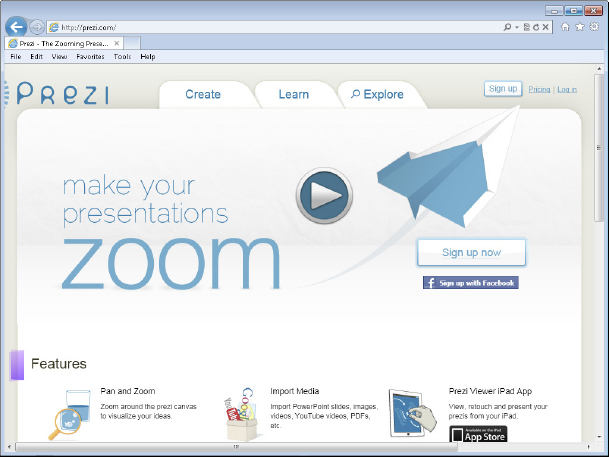
Sharing e-books
It seems like everyone is reading e-books. It's a convenient way to package up your brand's information and share it. Don't be limited by the notion that an e-book has to mimic a physical book. You can create e-books that include your product information, recommendations, and anything else that interests your customers.
For example, Seth Godin's Tales of the Revolution (Domino Project), promoted in Figure 7-24, tells the stories that happened as a result of the Domino Project publishing Poke the Box. The key idea here is that now that we can publish digital book content so inexpensively, we can make an e-book from almost any ideas. In contrast, when a physical book was the only option, many ideas weren't published because of the high cost of publishing a physical book.
Another great example of using both digital and physical books to spread ideas is the book, End Malaria, by Michael Bungay Stanier (Domino Project). This book (its accompanying website is shown in Figure 7-25) is available in hardcover and e-book formats. By partnering with sponsors who were committed to spreading the word, the book raised over three hundred thousand dollars to fight malaria.
Figure 7-24: Tales of the Revolution.
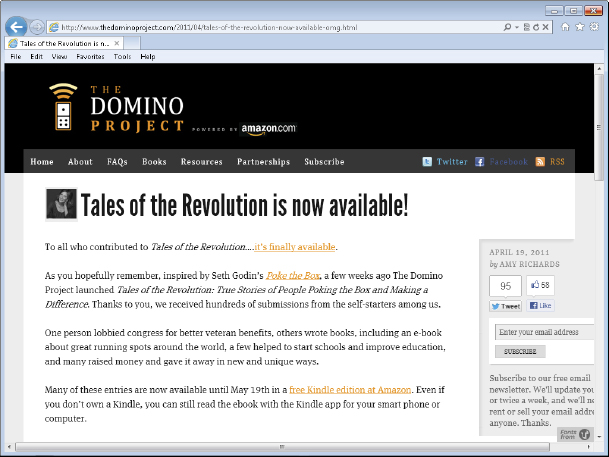
Rethinking what constitutes a book is a great way to make your own business content go viral.
 Amazon allows you to publish an e-book for distribution in the Kindle Store. If you think your e-book would have wide interest, consider submitting it to Amazon for consideration. Amazon must approve it before you list it. Also, the Kindle Store allows you to promote your book for free for a limited time to boost interest. Take advantage of that if possible.
Amazon allows you to publish an e-book for distribution in the Kindle Store. If you think your e-book would have wide interest, consider submitting it to Amazon for consideration. Amazon must approve it before you list it. Also, the Kindle Store allows you to promote your book for free for a limited time to boost interest. Take advantage of that if possible.
Mining the backchannel
Have you heard of the backchannel? If it sounds mysterious, it's not. The term backchannel refers to the stream of real-time comments on social platforms like Twitter when someone is giving a presentation. This can be another source of content from a presentation.
A few short years ago, the backchannel didn't exist. People sitting in the audience might comment to one another, but there was no widespread sharing of opinions on the spot. The backchannel allows anyone on a social platform to publicly share their opinions, make a nasty comment, or praise the speaker.
Some companies, aware of the power of the backchannel, establish a Twitter hashtag for a presentation before a conference or event begins. Companies know they can't control what's being said, but they can at least watch the comments along with everyone else. This is a good idea for your company. When you're aware of what the audience is saying, you may have the opportunity to modify what you're saying or respond to the comments.
At some conferences and other presentations, the backchannel comments are projected right on a big screen beside the presenters. When the comments appear on stage, the presenter can use those comments to further the discussion and extend the presentation's content.
One example of this is Pivot Conference (http://2012.pivotcon.com), as shown in Figure 7-26, a social media conference run by Brian Solis. Not only were the backchannel comments projected on the screen during the conference, but after the conference concluded, the conference presenters continued to capture tweets relating to the content. This is a great way to keep people engaged.
Figure 7-26: Pivot Conference.
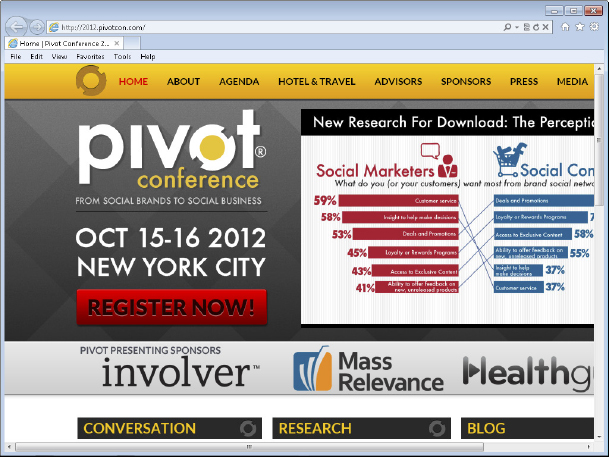
Having Influence
Influence is a topic that every online business wants to know more about. Robert Cialdini, a psychologist, has written a classic book on the topic called Influence: Science and Practice. In it, he outlines several ways that people are persuaded. They include things like reciprocity (you give something and get something in return) and social proof (other people have purchased a product before you and were satisfied).
Influence has taken on new importance for social media users because people who write blogs and communicate to large groups online now wield influence. Several tools measure influence, but it's hardly an exact science. There has been much debate about whether these tools really measure influence or just social media activity. Following are some free tools you may want to use to check your company's (or your own) influence score:
- Klout: This was the first of the influence ranking tools, launched in 2009. It's available at http://klout.com, and it measures your activity and influence across social media platforms including Twitter, Facebook, and Google+.
- Kred: This company's tagline is, “We all have kred somewhere.” With this as a starting point, this tool (available at http://kred.com) shows you your kred score (the highest is 1,000) and your outreach level (the highest is 12) based on your activity on Twitter.
- PeerIndex: This tool (available at www.peerindex.com) gives you a visual display of your areas of influence that it calls topic footprints. It also gives you a score that can be compared to others on the site.
